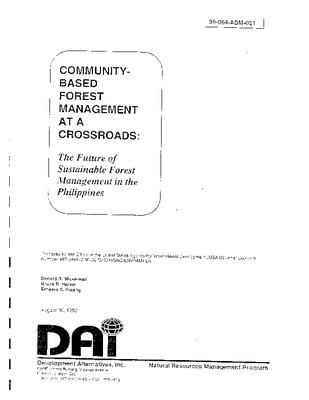Community-based forest management at a crossroads: The future of sustainable forest management in the Philippines
KEWWORD: Community-based Natural forest Management, Asia. Asia, Philippines, community forestry, logging, sustainable agriculture, sustainable forestry, agroforestry, conservation, contracts, institutional collaboration, institutions, policy, training, poverty abatement, lessons learned, project report. SUMMARY: This report is the narrative portion of the DAI Contract Completion Report for the Natural Resources Management Project-II. An overview of the U.S. Government’s support to Community-Based Forest Management in the Philippines is given before specific implementation details are examined. USAID’s role in developing community-based forest management (CBFM) in the Philippines has been very important. In the 1980s, projects established a foothold for new approaches to protecting forests. The focus was on communities at the boundaries of upland agriculture, agroforestry and standing timber. This was followed by the NRMP-I, which focused on policy and community-based management. This program has become the only proven, environmentally sound and sustainable means of forest management in this area. NRMP-II was established in 1995 and focused on counteracting policies detrimental to community-based management. In the following years, partnerships have been developed among institutions and local governmental units (LGUs), rights and responsibilities have been clarified, and strengths and weaknesses in the programs have become apparent. To highlight the issues that have emerged frequently, the authors examine 10 questions regarding these projects in the Philippines: What land area is CBFM designed to protect and rehabilitate? Who are the principle actors controlling CBFM’s fate and what is the primary policy challenge facing the program? How has NRMP assisted in improving procedures sustainable forestry? How can LGUs that promote forest communities become CBFMA recipients? What economic principles support CBFM agreements and industrial forest management agreements? How do planning and other spatial mapping programs contribute to sustainable forestry? Can the CBFMA-supported people’s organizations create viable cooperatives? The authors conclude that USAID’s leadership is still needed as CBFM establishes itself as a viable economic development strategy in the upland areas, and that USAID can make a significant contribution by providing high-level technical assistance. This includes professional skills to complete environmental assessments and technical surveys, and serve as the interface between local government units and the Philippine Department of Environment and Natural Resources.
https://biodiversitylinks.org/library/resources/rmp/library/content/tools/biodiversity-support-program/copy_of_cbnfm/USAID-BDB-cd-2-data/community-based-forest-management-at-a-crossroads-the-future-of-sustainable-forest-management-in-the-philippines/view
https://biodiversitylinks.org/library/resources/rmp/library/content/tools/biodiversity-support-program/copy_of_cbnfm/USAID-BDB-cd-2-data/community-based-forest-management-at-a-crossroads-the-future-of-sustainable-forest-management-in-the-philippines/@@download/image/image.png
File
Community-based forest management at a crossroads: The future of sustainable forest management in the Philippines
Author(s):
Mickelwait, D. R,
B. R. Harker,
E. S. Guiang
Location: Philippines
DOWNLOAD FILE
KEWWORD: Community-based Natural forest Management, Asia. Asia, Philippines, community forestry, logging, sustainable agriculture, sustainable forestry, agroforestry, conservation, contracts, institutional collaboration, institutions, policy, training, poverty abatement, lessons learned, project report. SUMMARY: This report is the narrative portion of the DAI Contract Completion Report for the Natural Resources Management Project-II. An overview of the U.S. Government’s support to Community-Based Forest Management in the Philippines is given before specific implementation details are examined. USAID’s role in developing community-based forest management (CBFM) in the Philippines has been very important. In the 1980s, projects established a foothold for new approaches to protecting forests. The focus was on communities at the boundaries of upland agriculture, agroforestry and standing timber. This was followed by the NRMP-I, which focused on policy and community-based management. This program has become the only proven, environmentally sound and sustainable means of forest management in this area. NRMP-II was established in 1995 and focused on counteracting policies detrimental to community-based management. In the following years, partnerships have been developed among institutions and local governmental units (LGUs), rights and responsibilities have been clarified, and strengths and weaknesses in the programs have become apparent. To highlight the issues that have emerged frequently, the authors examine 10 questions regarding these projects in the Philippines: What land area is CBFM designed to protect and rehabilitate? Who are the principle actors controlling CBFM’s fate and what is the primary policy challenge facing the program? How has NRMP assisted in improving procedures sustainable forestry? How can LGUs that promote forest communities become CBFMA recipients? What economic principles support CBFM agreements and industrial forest management agreements? How do planning and other spatial mapping programs contribute to sustainable forestry? Can the CBFMA-supported people’s organizations create viable cooperatives? The authors conclude that USAID’s leadership is still needed as CBFM establishes itself as a viable economic development strategy in the upland areas, and that USAID can make a significant contribution by providing high-level technical assistance. This includes professional skills to complete environmental assessments and technical surveys, and serve as the interface between local government units and the Philippine Department of Environment and Natural Resources.



